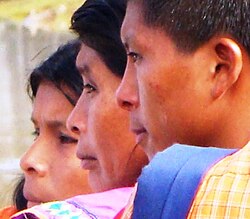Boruca
| Total population | |
|---|---|
| (2,660 (1990)) | |
| Regions with significant populations | |
|
|
|
| Languages | |
| Boruca, Spanish,Brunca Sign Language | |
| Related ethnic groups | |
| Bribri, Cabécar |
The Boruca (also known as the Brunca or the Brunka) are an indigenous people living in Costa Rica. The tribe has about 2,660 members, most of whom live on a reservation in the Puntarenas Province in southwestern Costa Rica, a few miles away from the Pan-American Highway where it follows the Rio Terraba. The ancestors of the modern Boruca made up a group of chiefdoms that ruled most of Costa Rica's Pacific coast, from Quepos to what is now the Panamanian border, including the Osa Peninsula. Boruca traditionally spoke the Boruca language, which is now nearly extinct.
Like their ancestors the Boruca are known for their art and craftwork, especially weaving and their distinctive painted balsa wood masks, which have become popular decorative items among Costa Ricans and tourists. These masks are important elements in the Borucas' annual Danza de los Diablitos ceremony, celebrated every winter since at least early colonial times. The Danza depicts the resistance of the "Diablito", representing the Boruca people, against the Spanish conquistadors.
The Boruca are a tribe of Southern Pacific Costa Rica, close to the Panama border. The tribe is a composite group, made up of the group that identified as Boruca before the Spanish colonization, as well as many neighbors and former enemies, including the Coto people, Turrucaca, Borucac, Quepos, and the Abubaes.
The population of the tribe numbers around 2,000, most of whom live on the Reserva Boruca or the neighboring indigenous reserve of Reserva Rey Curre. The Reserva Boruca-Terraba was among the first indigenous reserves established in Costa Rica in 1956. The lands currently on the reservations were named baldíos (common lands) by the General Law of Common Lands, passed by the national government in 1939, making them the inalienable and exclusive property of the indigenous people. The subsequent law of the Institute of Lands and Colonization (ITCO), passed in 1961, transferred the baldíos to state ownership. Law No. 7316, the Indigenous Law of Costa Rica, passed in 1977, laid out the fundamental rights of the indigenous peoples. This law defined "indigenous", established that the reserves would be self-governing, and set limitations on land use within the reserves.
...
Wikipedia

